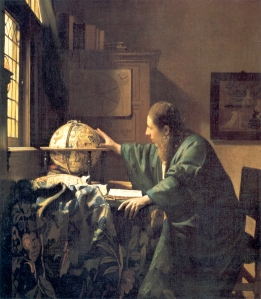John Law decided to use this evocative title because he liked the image of a constellation called Three Leaps of the Gazelle and he used it for the cover. It is a striking cover – a far cry, and literally eons, from the contemplative cloisters of his last album (reviewed by me here ). The origin of the phrase three leaps of the gazelle is from astronomy, three pairs of stars marking the hoof prints of a startled gazelle as it tried to escape a lion. More interestingly, the Arabic root of Gazelle means to display amorous behavior; to court, to woo. A ghazal is a particular type of Persian poem which most often expresses the pain of loss or separation and the beauty of love in spite of that pain. The gazelle is an appropriate image with its delicacy and limpid eyes.
OK so what has this to do with this very striking album? Well more than I realised on first listening. There is an Arabic feel to this album and it’s not just Asaf’s darbuka which gives it this flavour. Track five, Insistence, starts with the sound of crickets, you are in the desert, it is dusk, maybe there is a fire, fireflies flit around, the piano meanders in circles like a dance, a slightly sinister one with muffled piano, the drums are Arabic sounding, and then more crickets and it is dark – maybe you will see the constellation?
What I really love about John Law’s compositions is their subtlety. Effects are used sparingly, gently introduced on an ipod for live performance – the crickets in Insistence, the sound of New York traffic and chatting in a jazz club at the start of Swazz, the delicate fall of snowflakes (what else but a glockenspiel and some very high notes?). No danger of electronics adding stress to a performance.
He is joined on this album by Asaf Sirkis on drums and Yuri Goloubev on bass, both extraordinary. I love Asaf’s understated performance on this album, the exception to quiet being his solo in Three Part Invention ( I know he can play loud!) but most of the time his playing is delicate and shimmering, like a breath of wind. And Yuri brings Russian passion and Italian flare to the trio – his own website is in English and Italian. His bowing is exquisite and is given full rein in the title track. It goes without saying that John’s playing is awe-inspiring – a combination of heart and mind which I find irresistible.
With John you are never too far from classical music – his choice of Schumann’s Traumerei which creeps into Finger on the Pulse has also been used by Robert Mitchell on The Embrace. His tribute to Baroque is Three Part Invention, which he started on his album Congregation, taking it to another level here. The nimbleness of Yuri’s fingering (or is it bowing?) is breathtaking.
My favourite composition is Triadic Ballet – it’s a gentle tango with angular movements and undercurrents of passion and leaving – that ghazal poem again.
There are glorious tunes galore on this album, it will stay in my listening pile for a very long time. There is indeed a sense of loss when you get to the end of this album, like a ghazal poem, you have been held by its spell for 78 mins. One day I hope to see John again, so I can thank him for his magical music which touches me so deeply.
John Law, piano, keyboard, ipod
Yuri Goloubev, double bass
Asaf Sirkis, drums, percussion, glockenspiel, darbuka
All compositions by John Law
Three Leaps of the Gazelle, John Law’s Congregation featuring Yuri Goloubev and Asaf Sirkis, 2012 (33 Records 33JAZZ228) available from http://www.33jazz.com/


